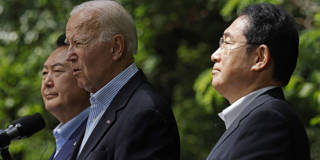Contrary to how it may appear to many, not least in the US, the new cold war seems to be based not on the old logic of polarization, but on a new logic of fragmentation. Judging by the growth of the BRICS group of major emerging economies, there is no shortage of countries that find that new logic enticing.
BERLIN – US President Joe Biden recently brought the leaders of allies Japan and South Korea to Camp David to discuss how to contain China and counter Russia’s influence, for example in Africa’s Sahel region, which has recently experienced a string of coups d’état. Meanwhile, leaders from the BRICS countries – Brazil, Russia, India, China, and South Africa – gathered in Johannesburg to criticize the West’s dominance over the international institutions established after World War II. It was enough to give Cold War historians déjà vu.
The West’s main adversary today is China, not the Soviet Union, and the BRICS is no Warsaw Pact. But with the world entering a period of uncertainty following the demise of the post-Cold War order, the parallels are sufficient to convince many to turn to pre-1989 conceptual models to gain insight into what might come next. This includes the US and China, though each is betting on a different model.
Between the end of WWII and the fall of the Berlin Wall, the two main forces defining the international order were ideological conflict, which split the world into two camps, and the quest for independence, which led to the proliferation of states, from 50 in 1945 to over 150 in 1989-1991. While the two forces interacted, ideological conflict was dominant: struggles for independence often morphed into proxy wars, and countries were forced either to join a bloc or define themselves by their “non-alignment.”

BERLIN – US President Joe Biden recently brought the leaders of allies Japan and South Korea to Camp David to discuss how to contain China and counter Russia’s influence, for example in Africa’s Sahel region, which has recently experienced a string of coups d’état. Meanwhile, leaders from the BRICS countries – Brazil, Russia, India, China, and South Africa – gathered in Johannesburg to criticize the West’s dominance over the international institutions established after World War II. It was enough to give Cold War historians déjà vu.
The West’s main adversary today is China, not the Soviet Union, and the BRICS is no Warsaw Pact. But with the world entering a period of uncertainty following the demise of the post-Cold War order, the parallels are sufficient to convince many to turn to pre-1989 conceptual models to gain insight into what might come next. This includes the US and China, though each is betting on a different model.
Between the end of WWII and the fall of the Berlin Wall, the two main forces defining the international order were ideological conflict, which split the world into two camps, and the quest for independence, which led to the proliferation of states, from 50 in 1945 to over 150 in 1989-1991. While the two forces interacted, ideological conflict was dominant: struggles for independence often morphed into proxy wars, and countries were forced either to join a bloc or define themselves by their “non-alignment.”